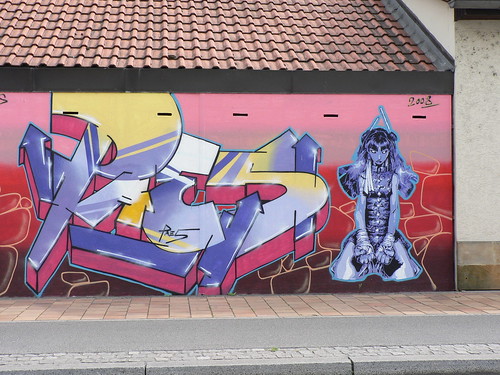tohm's Fashion Week (Or 5 things I don't like about fashion): 1
Globalisation is a tricky thing. Because it is impossible to feel the effect of globalisation by standing still. You have to travel (ironically) to feel the full weight of globalisation on this world. That is the feeling that no matter how far afield you travel in the world you are standing still.
To be sure, you can get sushi (nori) hand rolls in Ballarat now, and Thai Green Curries with actual Kafir leaves floating in them and this seems like an increase in consumer choices in sunny Ballarat. Before it was bakeries, and in the budding days of globalisation - McDonald's and KFC. So Ballarat seems to be a more colourful and exciting place thanks to globalisations.
But if some small Australian city in the corner of the world has Thai curries and sushi handrolls, then if you look in the opposite direction say the small Bavarian town of Bamberg and looked at your choices of cuisine you will find: Thai Green Curry and Sushi handrolls!
You see, to the individual standing still the globalisation seems to make the world a more interesting place, but to the individual moving the world has lost its luster in its homogenized state.
Ballarat to Bamberg the world is truly becoming a global village. All we need is for Middle Eastern and African cuisines and soon everywhere will have the cuisine same as everywhere else. (admittedly in Germany you can find the sausage stands which you can't find in Australia...yet).
But what of fashion - you don't see shirts saying 'Paris, London, Tokyo, New York, Bamberg, Ballarat' but that's what globalisation means to fashion. The distribution chanels have changed such that the epicenters are more influential than ever.
When 'A Bathing Ape' founder Nigo started out, he would fly to the US and buy up stock to send home, back in the late 80's early 90's. New York would heavily influence Japanese fashion, but back then it required a 20 hour round trip flight.
Which sounds incredibly fast, but 20 years on the internet has made the process of 'coolhunting' much, much, much faster.
I hate cool hunting, and you know the saying 'by the time you hear about the bandwagon, it's already too late' well if the aim of being cool in its unrefined form is to express yourself as an independant individual, that bandwagon moves at a blistering speed through fibre optic cables to just about any corner of the globe that isn't dfependant on an Australian government to give it bandwidth.
For example, let's stay in Harajuku and look at Fruits magazine.
If you click on this link you will go to the magazines telling home page.
Why I say 'telling' is that it has 'japanese' and 'english' on it. So the magazine isn't exactly a hard to come by local publication anymore. What started as one guy documenting the handmade fashion of Tokyo youth has ended up as this. And inevitably that lead to Gwen Stefani putting her name on imitations of Japanese kids fashion creations and selling them right back to them. And publications like the sartorialist.
I know there are London spin offs of Fruits, and varying imitations of the Sartorialist, ranging to Copenhagen Chic (which adds bicycles to the voyeurism) and well anyone can find these places interesting.
What is the what? I hate globalisation but anyone (including me) can find these coolhunting, fashion agregators interesting?
What am I saying? If you combined all these pages together, you would have about 200 different styles a year from sartorialist alone, 900 or so from the fruits franchise, and eventually 1200 new choices every year. Only some kind of statistition could filter through all the aggregates and determine the 'style trends' in one monotonous glob right?
Well there's always choices, even when it comes to school uniforms. Long socks or short socks? Socks up vs. Socks down? Shorts in winter? School boy knot or double-windsor? long sleeves vs. short sleeves? top button open or closed? shirt tucked in or not? Traditional buckle or modern? etc.
But as far as I know from marketing about 25% of people in the world think for themselves, another 50% do pretty much what they are told and another 25% don't think about other people at all. (you can pick them by their IT and Engineering attire).
That 50% band is what gets up my nose, and has become increasingly odious as globalisation has spread. Think about it, 10 years ago there would have been 100 coolhunters in New York getting roughly the same amount of business. Now I would guestimate that there would still be 100 (if not 1000) cool hunters in New York, but 1 of them (ie. the sartorialist) would be getting more clientelle (even if they don't pay him anything) than the other 999 combined. His blog proudly proclaimes 'selected as one of Time magazines Top 100 design influencers'.
The way most ladders work particularly in the commercial realm is that no.1 will have 60% of the market share, no.2 will have 30%, no.3 10%, no.4 3% and so on downwards in ever diminishing supplies.
The internet has meant that fashion 'trends' can be preserved and transmitted in greater quantities and higher fidelity than ever before. The result? If you are in Ballarat or Bamberg, it means you are dazzled with the 1200 new choices every year, because back in the day it used to be roughly 4 new choices every year.
But what has been lost is the vast opportunities for mutation.
Take for example the following test (no mouseovers):
Q: What city is this in?
Can you honestly answer that question? My guess is - no. You can't.
Only those studying psychology may guess that I was too mentally strained to try and recall another across the world and out of the way city to use as an example so I just googled 'bamberg graffiti' even then I can't say for sure that this picture is in Bamberg. There was no caption.
An architecture major might recognise the roof tiles as germanic...
Anyway, graffiti is one of the most globalised fashions in the world. Whereas in the 80's every city had it's notorious players, the notority of the city stars has shrunk and Banksy's has grown to engulf everyone everywhere.
But it's interesting to pick up the book King's Way documenting Melbourne graffiti between 1983-93. it demonstrates fashions ability to mutate.
Globalisation had started for sure, with the advent of MTV and stuff as our first fashion agregators (or coolhunters) but when you flick through the pages of King's Way, what you won't see is a bunch of Melbourne Graffiti artists dressed in the same exact clothes as the graffiti artists of Brooklyn, but kids that look like they are living in Orbost today. Denim jackets, mullets, freckles etc.
Like a game of chinese whispers the underground culture originating from Brooklyn mutated with every ear and eye it passed through. The expense and sheer effort involved in sourcing clothing and styles from the US made local manufacturers and surf brands preferable and easier to stock.
1200 new styles a year may sound like a lot, but before fashion started globalising, there would have been 1,000,000 new styles a year - you just didn't notice them because you had no portal to see them through.
But I'd take a big bet that back in the 1980's if you took a train (or whatever) from New York to Chicago the teenagers in each city would look different. They would dress different and whatever. The most homogenous items (yet still localised) would probably be sports attire. At any rate, there would have been more distinct styles on just the east coast than there is today where sports attire is probably now the most differentiated attire. I'd be willing to bet I could find a couple of fashion journalists who had done such a thing and would testify to it.
But I'm just taking the principals of 'scalability' from 'The Black Swan' to predict the past (not an easy thing to do) of something I never experienced personally.
But I have experienced culture shock of passing through different country towns of Victoria. The rules for acceptable attire changed more than they do now. Billabong and Quicksilver (and now Roxy) being primarily responsible for the homogenisation of bogan fashion.
Thus in conclusion we are left with a prisoner's dilemma, when you are isolated from world fashion aggregators (coolhunters) you have less choices (say 30) albeit of local mutations of fashion that are actually more unique. When you do use world fashion aggregators you have more choices (say 300 for the average individual) that are in fact carbon copies and not really unique at all.
I see no way to combat globalisation apart from making your own clothes, but then there's nothing to stop the sartorialist or some other coolhunter wandering up and snapping a photo of you and next thing you know you are buying a copy of your clothes off Gwen Stefani. Perhaps the simplest thing to do is just displace yourself linearly in time, and simply read last years Sartorialist post corresponding to todays date... but then again fashion moves in ever tightening cycles (remember the 80's revival in the early 90's).
More tomorrow.
P.S. Incidentally this post was inspired by the ironically stupid 'Secret Melbourne' group on facebook, yet I haven't needed to mention it until the post script which is superfluous to the thesis. I checked it out, although its name pretty much says it all, and its only saving grace is that a constant stream of wall posts make it a very user unfriendly fashion aggregator. Furthermore people's 'secrets' are impossible to evaluate in any objective way. Further to that I assume its going to appeal to a kind of person unlikely to contribute something worth keeping secret, but really with 1,400 fans and counting to scour the CBD for 'cool' spots, they are bound to find everywhere eventually. If you want more mutants and less clones though, dropping this group may be a good place to start.

No comments:
Post a Comment